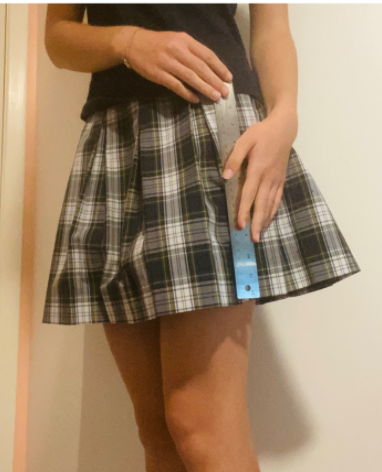The Sexist Reality of Dress Codes
What protects a young teenage girl from being a woman? The answer: a plaid skirt, 5 inches above the line from the back of her knee. This question comes at a time when girls and women throughout the country, from the Olympics to the classroom, are challenging society’s entrenched discomfort towards the female form. In academic institutions, this discomfort manifests through inherently sexist dress codes, and the Village School is no exception to this provocative dilemma.
Complaints started arising in early August as female students were being asked in front of their peers to “lower their skirts.” I was one of them. Upon entering school with a friend one day, instead of being welcomed with a warm smile from our teachers, we were greeted with a sharp stare at our thighs and a gruff, “Ah, here’s another one,” before being redirected to a teacher who, in front of the patio brimming with our peers, demanded we lower our skirts. As we struggled to do so, the teacher accused us of rolling up our skirts in order to “show off our legs”. While this brief comment seemed unimportant at the time, it surfaced an intriguing question, one that would be the motivator behind this entire article: How could something as unsexual as the inches above my knees warrant such a poignant examination, not only of my outfit, but my actions, my motivations, and my character? This is not a unique case nor a unique question, but one that highlights how girls are disproportionately disciplined and their bodies excessively policed.
The answer to this question is simple. The fact is that the few inches of skin above my knees, in our current society, are inherently sexual, as is my entire body. Thus, to avoid ever having to confront our entrenched discomfort and rampant sexualization of the female form, dress codes were created. Yet, today, instead of avoiding such biases, we feed them, making the dress code’s enforcement fundamentally discriminatory. Most schools view the female body as a distraction, saying that the dress code is in place to minimize disturbances, A.K.A. the ever-looming threat to education that is my teenage body. That is the current rationale of The Village School
“The uniform is intended to minimize distractions so students can focus on school activities,” said Jennifer Thomas, the assistant head of school. “How someone wears their uniform should not make someone feel uncomfortable or make parents concerned about what their child may see at school. Some parents have expressed deep concern that their child sees girls wearing skirts extremely short and what message this sends to them.”
Such rationale is indicative of a broader societal ideology in which girls, all of whom are 18 or under, are making adults uncomfortable. The question is why? Why are a girl’s thighs detrimental to education? What message do short skirts send to developing youth? The answer is nothing. It is not detrimental unless we attach a connotation to such shortness and the female body. Unless we sexualize adolescent girls. But the issue is we do sexualize young girls. We carry this mindset when we reduce a young girl’s body to a “distraction”, to something that needs to be covered for the sake of their education and their success in the world. But the truth is, this thinking is fallacious. I am a girl with female anatomy and I am a top student. The length of my skirt does not impede my successes nor does it impede my peers’. Yet, girls’ bodies have become objects of adult judgment and surveillance, something to be controlled, and viewed as dangerous, a threat to education.
This view harms students immensely. High school is a time of self-discovery, including bodily and sexual discovery. Therefore, our demonizing ideology of girls’ bodies limits their confidence and sense of self, affecting even widely successful students like the president of the student body, Esha Garg.
“I internalized this rhetoric to the point where I feel uncomfortable when wearing a skirt,” said Garg. “How long should it be? I don’t want someone calling me a nun if it is too long or calling me another bad word if I wear it ‘too short’.”
Girls worry about how their bodies will be demeaned in a sexual context. Are they prudes or are they sluts? Either way, they are shamed. Such questions are ones that girls grapple with daily.
“We are telling young women that their body is dangerous and that they are at all moments sexual beings,” said Dr. Helena Michie, head of Women, Gender, and Sexuality studies at Rice University. “The people who are imagined being protected by these dress codes are straight, young men who are imagined not only as unable to control themselves and easily distracted but to have a right not to control themselves.”
Dr. Michie brings up another valuable aspect of this dress code conversation: that dress codes are less about education and protecting girls than they are about enforcing sexist ideology and the problematic “boys will be boys” mentality used to justify sexual harassment.
In our common society, we believe, as shown through dress codes, that it is a girl’s role to protect herself from unwanted attention and that by wearing “revealing” clothing (showing her legs) she is asking for a sexual response from boys. This is where we normalize male entitlement to a woman’s body in a public space, like school. For instead of teaching our boys to respect girls, we are teaching girls that what they wear defines their right to respect and their worth. It’s no shock that after bathing in this ideology in high school that it continues into college, where 1 in 5 women are sexually assaulted. We have a sexual violence crisis in the US and sadly schools are perpetuating problematic rationale, prolonging this crisis. It has to stop, and at the Village School, progress is now being made.
The anger and confusion of students on such sexist uniform enforcement reached the ears of the administration and Student Government, who addressed this issue in a uniform forum held in late September. The forum was quite successful, with over 30 students attending. It was a progressive and communicative step forward that showed students their concerns were being taken seriously and opened conversations about how the uniform could be enforced more equitably. At the forum, it was officially announced that skirt lengths would now need to be fingertip length, around mid-thigh (which is the average skirt length) instead of knee-length. Similarly, enforcements like the one I received have significantly decreased. This forum was a shining example of what needs to be happening in more schools across the country, as schools need to hold discussions that work to dismantle bias and revise dress codes.
Yes, dress codes are sexist and demonstrate our discomfort towards the female form, but students are rallying for their advancement. So that one day, a plaid skirt won’t be the defining factor of a girl’s maturity or value. That she will be judged solely by the content of her character and not by the length of her skirt.
Solemei Scamaroni is a senior serving her third year on The Viking Press. An avid competitor in Speech & Debate, Solemei is fascinated with politics...






